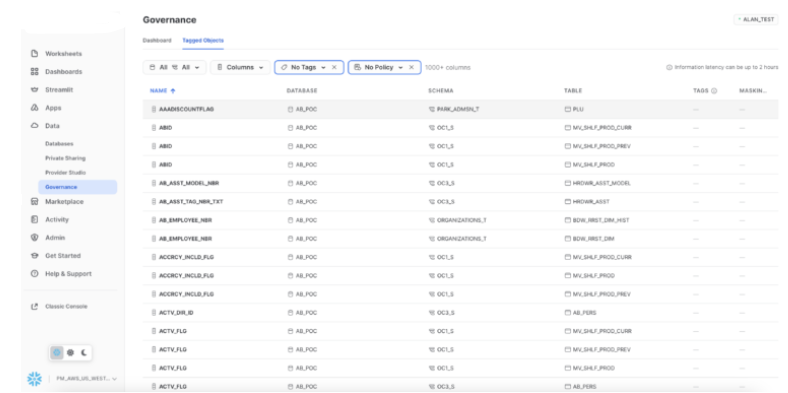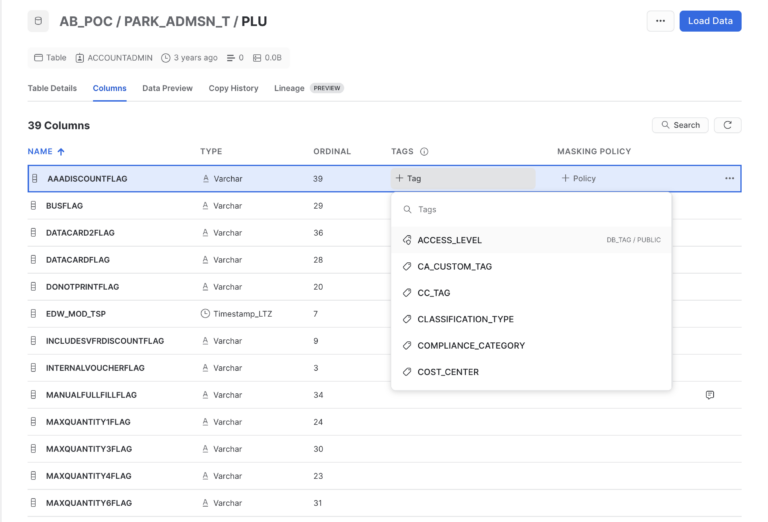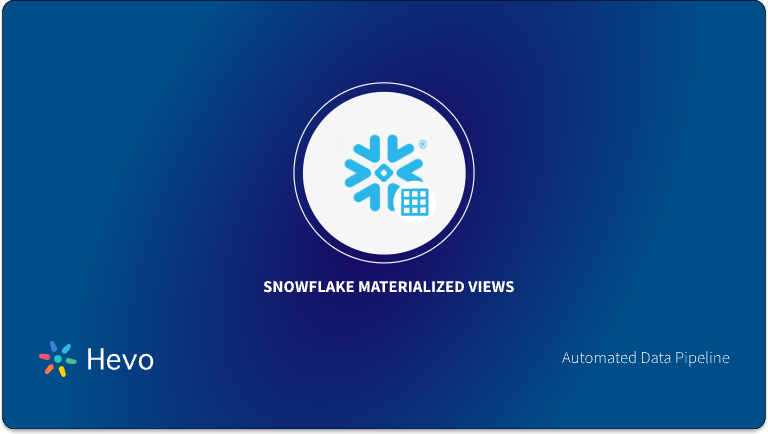Data governance is essential for any organization managing large amounts of data, and Snowflake makes it easier with its built-in tools and features. Snowflake Data Governance ensures that your data is secure, compliant, and accessible to the right users, helping you meet regulatory requirements while maximizing the value of your data.
In this blog, we’ll explore what Snowflake Data Governance is, why it’s important, and provide a step-by-step guide to setting it up. We’ll also share best practices to ensure your data remains well-governed, secure, and trustworthy throughout its lifecycle. Let’s dive in!
Table of Contents
What is Data Governance in Snowflake?
While Snowflake enables you to handle increasing volumes of data, you must implement a robust data governance procedure to ensure data compliance. An adequate data governance approach helps ensure business data quality, integrity, security, and availability.
Data governance structure provides industry-leading features that enable the highest level of governance for your organizational data stored in the Snowflake warehouse.
With data governance in Snowflake, you can do the following:
- Monitor your data
- Ensure data consistency
- Reduce the risk of a data breach
- Comply with regulatory requirements like GDPR or HIPAA
- Create policies for data retention and deletion
- Improve trust and confidence in your data for users, and much more for better data management.
Data governance in Snowflake not only addresses the key areas that need attention but also drives business growth by maximizing the value of data and making it secure.
Looking for the best ETL tools to connect your Snowflake account? Rest assured, Hevo’s no-code platform seamlessly integrates with Snowflake streamlining your ETL process. Try Hevo and equip your team to:
- Integrate data from 150+ sources(60+ free sources).
- Simplify data mapping with an intuitive, user-friendly interface.
- Instantly load and sync your transformed data into Snowflake.
Choose Hevo and see why Deliverr says- “The combination of Hevo and Snowflake has worked best for us. ”
Get Started with Hevo for FreeKey Features of Snowflake Data Governance
There is a comprehensive set of data governance Snowflake features that help you effectively manage your data. The features include the following:
1. Data Metrics Function
- Snowflake data governance allows you to monitor the integrity and state of your data using data metrics functions (DMFs).
- By applying DMFs, you can study your data by measuring key metrics such as freshness, duplicate or unique values, and NULLs. Although Snowflake provides built-in DMF functions, you can customize them to measure data quality more precisely.
2. Column-Level Security
The column-level security feature is supported in Snowflake Enterprise Edition or higher. This feature allows you to apply a masking policy to the column’s data in the Snowflake table. Currently, Snowflake’s column-level security has two features:
- Dynamic Data Masking: You can use dynamic data masking to selectively mask data in tables and view columns when querying. It helps you ensure that only authorized users can view the actual data.
- External Tokenization: Data tokenization is replacing sensitive data with an undecipherable token. By implementing external tokenization, you can tokenize data before loading it into a Snowflake table and detokenize it at query runtime.
3. Row-Level Security
- You can use Snowflake’s row-level security feature through row access policies, which are schema-level objects, to limit the access of particular rows in a table.
- The policies help you determine if you can view a row using statements such as SELECT, UPDATE, DELETE, or MERGE. Row-level security enables data governance by limiting access to sensitive data.
4. Object Tagging
- Snowflake supports this feature in the Enterprise edition or higher. Snowflake’s object tagging feature allows you to track sensitive information for compliance, protection, discovery, and resource usage.
- It supports a centralized and decentralized data management approach, facilitating compliance with external and internal regulatory requirements.
- Object tags are labels that let you assign metadata to objects in Snowflake, such as tables, views, or schema.
- You can create a tag using the CREATE TAG statement and assign a single tag to multiple columns. The Snowflake tag consists of key-value pairs. The value of it should be unique and string value.
5. Data Classification
- Data classification is a multiple-step process associated with defined system tags for columns. It analyzes fields and metadata.
- You can classify columns in a Snowflake table to determine if they contain data that needs to be protected or tracked. With classification, you can improve your data governance structure as it facilitates compliance with data privacy regulations.
6. Object Dependencies
- Object dependency allows you to operate on an object. The object should have a reference to metadata for itself or some other object while working on it.
- You can create a view for an account when data sharing is performed. This feature is supported on your local Snowflake account and helps you enhance data integrity and compliance.
How to Implement Data Governance in Snowflake
Follow the steps below to implement data governance in Snowflake. Please note that you need account_admin permissions to access the data governance interface.
- Step 1: Open the data governance interface to the Snowflake account.
- Step 2: You can view the number of objects with tags and policies illustrated on the governance interface.

- Step 3: You can analyze data governance for any object by accessing and implementing customized filters.

- Step 4: Select a particular object from the tagged objects page to apply tags or data governance policies to data. Click on +Tag or +Policy to assign tags or policies.

Tools Used to Implement Effective Data Governance in Snowflake
Various tools help you implement data governance in Snowflake. Let’s look at some of the prominent governance tools:
1. Alation
- Alation is a data governance tool that helps you identify critical datasets, understand and manage them, and catalog them for validation and repurpose.
- It is an ideal solution to implement Snowflake data governance, as it helps you centralize data, adhere to data access and usage policies, and foster collaboration.
2. Collibra
- Collibra is an enterprise-oriented data governance tool that helps businesses understand and manage data assets.
- It aims to protect data and ensure regulatory compliance by creating an inventory of data and capturing related metadata. You can integrate Collibra with Snowflake to handle and scale your data assets while ensuring governance.
3. Talend
- Talend is a data governance tool that provides data management using intelligent technologies like data cataloging, data lineage, pattern recognition, and machine learning.
- Combining Talend with Snowflake allows you to implement suitable security measures for data ownership, remediation, curation, and reuse, ensuring data governance is met.
4. Atlan
- Altan is a governance tool that helps you transform complex data governance processes into a simple, more understandable approach.
- You can scale your data management using Atlan to implement data governance in Snowflake. It lets you implement crawling and cataloging your data asset in Snowflake, driving self-service data discovery.
- Atlan also protects sensitive data by auto-classifying PII data such as email, phone number, card information, and more.
Read more about The Best Data Governance Tools for 2025.
Challenges In Implementing Snowflake Data Governance
Even though Snowflake offers a solid foundation for data governance, it faces some challenges when implementing governance policies.
- Data Lineage: Snowflake stores metadata information at the object level. This storage method makes it difficult to understand data flow and implement consistent data governance policies on dependent objects.
- Data Discovery: The two essential components of data governance are availability and usability. While Snowflake is widely used for data management, it does natively offer data cataloging and business glossary, which makes it challenging to find and use data.
- Multiple Data Sources: As Snowflake accommodates data from various sources, it becomes difficult to ensure proper access controls. You need to filter data to manage and adhere to data governance regulations.
The above challenges can make implementing a robust data governance framework in Snowflake difficult. However, you can address these limitations using third-party tools, such as Hevo, which will help you build a foundation for data governance in Snowflake.
What are Some of the Best Practices for Implementing Data Governance in Snowflake?
Implementing a sturdy data governance framework in Snowflake requires several best practices. Here are some of them:
1. Develop a Governance Framework
You should develop a robust data governance framework to govern data in Snowlfkae in a structured manner. The framework must include:
- Essential guidelines to design scalable data models in Snowflake.
- Strategies for proper data processing and storage to optimize resource management.
- Alignment with industry standards specific to cloud computing for data security and to perform sound integration.
2. Set up a Data Governance Team
Setting up a data governance team or committee is essential to help you develop and implement rules and policies related to your data. Each member’s responsibility should be clearly defined to ensure the governance program aligns with your organization’s data needs. For instance:
- Your organization’s chief data officer should oversee the Snowflake data governance framework and ensure its alignment with business needs.
- Your team’s data governance lead should develop and implement policies and procedures and ensure coordination among the organization’s teams.
- The data security officer in the organization is responsible for implementing security and monitoring policies to ensure compliance with regulatory standards.
3. Define Security Measures and Data Quality Standards
Establishing security measures to protect your data from unauthorized access is essential. These measures must include access controls, data masking, encryption, and more. By implementing security policies, you can decrease incident response time. You must also implement data quality standards for validation, cleaning, and enrichment. These standards enhance your business data quality and make data more reliable and consistent.
Conclusion
Various Snowflake governance features allow you to manage data and implement policies effectively. Judiciously using these built-in data governance features, you can classify your datasets and ensure their quality and integrity.
Integrating your data with Hevo improves data consistency. The platform’s flexible, no-code data pipeline allows you to transform and migrate data. Implementing these strategies within Snowflake can help you comply with essential regulatory compliances to derive business value.
Want to take Hevo for a spin? Sign Up or a 14-day free trial and experience the feature-rich Hevo suite firsthand. Also checkout our unbeatable pricing to choose the best plan for your organization.
FAQs
1. Is Snowflake a data governance tool?
No, Snowflake is a cloud-based data platform, but it supports data governance by providing features like data access controls, encryption, and auditing.
2. What is Snowflake data management?
Snowflake data management refers to managing data storage, access, performance, and processing in Snowflake’s cloud data platform, allowing users to store and query large amounts of data efficiently.
3. Is Snowflake a database or ETL?
Snowflake is primarily a cloud database (Data Warehouse), but it can also support ETL processes by integrating with ETL tools and allowing data transformations using SQL.












